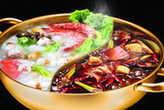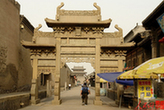For those who want to experience the real Beijing, the hutongs and Siheyuans (quadrangle) are indispensable parts of a visit as unique Beijing architectural structures.
Hutongs
A hutong is an ancient city alley or lane typical in Beijing, where hutongs run into the several thousand. Surrounding the Forbidden City, many were built during the Yuan, Ming and Qing dynasties (1271-1911). In these dynasties the emperors planned the city and arranged the residential areas according to the etiquette systems. The center of the city of Beijing was the royal palace -- the Forbidden City.
The word "hutong" came from the Mongolian language about 700 years ago. It originates from the word "hottog" in Mongolian meaning "water well." Where there was a spring or well, there were residents. The word "hottog" became "hutong" after it was introduced into Beijing.
Hutong means street, lane and alley, and is in fact the passage formed by lines of siheyuans (quadrangle) where most Beijing residents live. One hutong connects with another, and siheyuan connects with siheyuan, to form a block, and blocks join with blocks to form the whole city.
In old China, there was a clear definition for a street or a lane. A 36-meter-wide road was called a big street. An 18-meter-wide one was called a small street. A 9-meter-wide lane was called a hutong. The shortest one is just 10 meters long, and the narrowest hutong is only about 40 centimeters wide. Some hutong have more than 20 turns. Most of the hutongs in Beijing are in east-west or south-north directions. That has resulted from the need for houses to face south so as to take in more sunshine.
There are many stories and fairy tales about hutong. Near the Forbidden City, in the heart of Beijing lies a hutong called "Girl Weaver," which is named after a fairy from the Heavenly Kingdom, who descended to the human world and married a cowherd. Her enraged father, the Celestial Emperor, took the girl back and separated the couple with the Milky Way.
Symmetrically, on the other side of the Forbidden City, there used to be a Cowherd Bridge. This arrangement seems to suggest that feudal emperors living in the Forbidden City are sons of Heaven.
In the rich and historical culture of Beijing, the hutong has a very special and important position. It is not only a kind of architecture, but also serves as a window into Beijing folk life and the "encyclopedia of the history and culture of Beijing."
Siheyuan
Beijing hutongs are formed by lines of siheyuan (a compound with houses around a courtyard) where old Beijing residents live.
A standard siheyuan usually consists of houses on its four sides, and the house which stands at the north end and faces the south is called the "main house" or "north house," the ones on both sides are called "side houses," and the one which stands at the south end and faces north is called "opposite house" or "south house."





Why not rent a boyfriend, or girlfriend to please parents during the Spring Festival?